When I was growing up, my father was just beginning his career as a stockbroker and we didn’t have much money. We had beef twice a month, on pay days. My mother had to find creative ways to stretch the income to feed our family of six. As a result, we grew up eating a lot of casseroles. Macaroni and cheese, ham and noodles, and of course the ever popular tuna casserole were such regulars at our dinner table that my brothers became bored with them. Being the youngest, by the time I came along my father was starting to earn more money and casseroles were more of a novelty for me. I still love them. For me they don’t have the unhappy association with being poor that they do for my brothers.
Casseroles have been around for centuries in one form or another, but what we consider a casserole today arrived in the 1800’s. A combination of a starch (usually pasta or rice) with a sauce and a little protein can feed a lot of people for a low cost. Especially helpful to housewives during the 1930’s during the Great Depression, casseroles continued to be an integral part of meal planning in the 1940’s due to World War II rationing. In the post war years when women began to form a larger percentage of the workforce, casseroles were an easy way to get a filling hot dinner on the table after they got home from work. By the time we hit the 60’s and 70’s with the evolution of canned and frozen foods, it was more about convenience than economics.
Tuna was first commercially canned in 1903, but it wasn’t readily accepted. It took a lot of marketing and persuasion to get home cooks to consider it an acceptable protein source. Tuna salad sandwiches didn’t become a staple until the 1950’s. But it was the combination of Campbell’s Cream of Mushroom soup with tuna and noodles that made it a national dish.

Tuna packed in Olive Oil
Cream of Mushroom soup arrived in 1934 and was hyped as both an appetizer and because it was condensed, as the base for many sauces. The booklet “Helps for the Hostess” stated, “Many times unattractive leftovers were thrown away when, by using a can of Campbell’s Soup, they could have been made into an attractive, appetizing dish.” Then they gave housewives a general recipe for turning any can of condensed soup into a sauce. For the first time a sauce became an easy to make accompaniment and integral part of composed dishes.
While recipes for tuna casserole made with cream of mushroom soup can be found anywhere, I wanted an updated version to share with you. Today’s recipe is from Mark Peel, executive chef of Campanile Restaurant in Los Angeles for the past 20 years. Mark began his career working for Wolfgang Puck at Ma Maison. Under Puck’s tutelage, he apprenticed at restaurants in France before returning to be Sous chef at Michael’s restaurant where he met his future wife, Nancy Silverton. He then spent a year working with Alice Waters at Chez Panisse in Berkeley before heading back south to open Spago as its head chef under Puck. In 1989 he opened Campanile.
Campanile is housed in a dramatic historic structure built in 1929 for Charlie Chaplin. Originally intended as a combination retail/office site, Chaplin never took occupancy before losing the building in a divorce. After decades of neglect, Mark, Nancy, and wine director Manfred Krankl purchased it and undertook a complete remodel. They turned it into an amazing space that houses the restaurant and La Brea Bakery. Both are beloved Los Angeles institutions and have received a remarkable array of awards over the years. Some of the most notable are Food & Wine’s Best New Chef, DiRona’s Distinguished Restaurant of North America, and multiple nominations for James Beard Best American Chef.
Campanile’s menu celebrates the incredible bounty of California with rustic elegance and simple dishes. It changes daily to take advantage of the freshest organically grown produce, herbs, and naturally raised meats available. You might start your meal with Cast-Iron Duck Meatballs with smoked mozzarella and a roasted tomato sauce, followed by their Frisee and Poached Egg Salad. As a main course you could choose Grilled Prime Rib, Pan-Seared White Salmon, or a hearty Bolognese. And by all means leave room for the amazing desserts from Nancy Silverton’s La Brea Bakery. I can certainly lose myself in her Chocolate Truffle Cake, Passion Fruit Cheesecake, and Chocolate Macadamia Tart!
Monday nights are Family Dinner Night at Campanile. Each week they offer a different three-course menu served family-style. Inspired by the fresh ingredients he finds at the farmer’s market, Chef Peel creates each menu around a theme. Some of the most popular are Clam Bake, Fried Chicken, and Julia Child’s Beef Bourguignon. Today’s recipe comes from the acclaimed “New Classic Family Dinners” based on those Monday night menus.
Chef Peel’s interpretation of Tuna Casserole is infinitely better than anything created from canned ingredients. Starting with a white sauce that is seasoned with onion, bay leaf, and a dried red chile, his version is quite simple. He doesn’t add peas and carrots but I have included them in my modifications. It is a great way to increase our intake of vegetables and I like the color they add to the casserole. You can certainly incorporate your favorite par-cooked vegetables as desired. Broccoli, cauliflower, and mushrooms would all be welcome additions.He uses Gruyere and Parmesan instead of the more traditional grated Cheddar for a piquant flavor.
Have fun with this recreated favorite!
Jane’s Tips and Hints:
One of my favorite kitchen tools is my 9×13-inch baking pan that came with a plastic lid that snaps on. I use it for all kinds of tasks, and it is perfect for recipes like this casserole. If you make it ahead or have leftovers, you can store them easily in the refrigerator. And the best part … they are not expensive!
Kitchen Skill: How to Cut a Carrot into Cubes
Whenever you are working with round ingredients like potatoes or carrots, it is important to make them stable. To do this cut a thin slice lengthwise off one side creating a flat surface. Set the carrot on the flat side and cut thin slices lengthwise off each side and the top, creating a four-sided shape like a very long, narrow, cube. If the carrot is especially thick, cut it in half lengthwise first and then make remaining cuts. Turn the carrot crosswise and cut into desired size cubes.
I always sharpen my knife before starting so I don’t have to press hard to make my cuts. A sharp knife eliminates most accidents in the kitchen. Once you have cut a few of these for your own dinner, when you see perfectly cut carrots at a restaurant, you will appreciate the effort that went into the preparation!
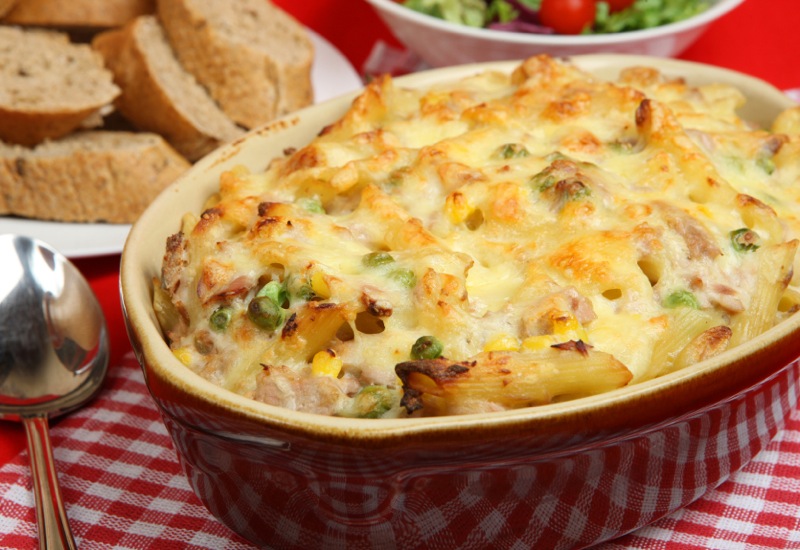

- For Bechamel
- 3 tbsp butter
- 3 tbsp all-purpose flour
- 1/4 cup minced onions or shallots
- 1 small dried red chile (preferably Japanese), whole (leave out if desired)
- 1 small bay leaf
- Kosher salt
- 2-1/2 cups whole milk
- For Casserole
- 1/2 lb pasta. such as penne, macaroni, fusilli, or rotelle
- 2 tbsp olive oil from tuna
- 2 (6 oz) cans imported tuna packed in olive oil
- 1/4 cup frozen baby peas (petit pois)
- 1/4 cup finely cubed carrots, lightly steamed
- 4 oz Gruyere cheese, grated (1 cup tightly packed)
- 3 tbsp minced fresh flat-leaf parsley
- 1-1/2 cups (2 oz) fresh breadcrumbs
- 1-1/2 oz Parmesan cheese, freshly grated (1/3 cup tightly packed)
- Make the Bechamel: In a medium saucepan over medium heat, melt butter and add flour. Stir together with a wooden spoon until roux is just barely golden and has a popcorn aroma, about 5 minutes. Add onion or shallot, chile, and bay leaf and continue to cook, stirring, until onion softens slightly and the raw onion smell is gone. Add 1/4 tsp salt. The popcorn smell will dissipate and the roux will thicken, and then, after 2 to 3 minutes, it will loosen up.
- Change from the wooden spoon to a whisk and pour in milk all at once, whisking vigorously. Bring slowly to a simmer, whisking continuously until sauce thickens. Use a heatproof rubber spatula to scrape the sauce from the bottom and edges of the pot so it doesn’t stick and burn. It helps to cook the bechamel in a wide pan you can tip to see the bottom to make sure the sauce is not sticking. Reduce heat and simmer gently, scraping sides and bottom of the pot from time to time, for about 15 minutes, until there is no trace of a floury taste.
- Remove from heat and strain immediately, while hot, through a medium strainer into a bowl; discard solids. Taste and adjust the seasoning (you will probably want to add up to 1/4 tsp salt); it should be well seasoned and medium thick. You can store bechamel for a few days in the refrigerator. Place a piece of plastic wrap directly on the surface to prevent a thick skin from forming. When you reheat, remove plastic and whisk vigorously.
- Assemble the Casserole: Preheat oven to 350°F. Butter a 2-quart baking dish.
- Bring a large pot of water to a boil and add a generous tbsp of salt. Add pasta and cook for a minute less than usual. It should be cooked through but a little more al dente or chewy than you’d like it if you were serving it right away. I usually cook it about 2/3 the time indicated on the package. Remove 1/4 cup of the cooking water and set aside in a bowl. Drain pasta and place in a large bowl. Toss with a tbsp of oil from the tuna.
- Crumble tuna into the bowl with the pasta and toss together. Gently fold in the bechamel, grated Gruyere,and 2 tbsp parsley. If the sauce seems to coat the pasta too thickly, thin out with a small amount of pasta cooking water (2 tbsp or a little more). Spoon into prepared baking dish.
- Mix together breadcrumbs, Parmesan, remaining tbsp ofparsley, and the remaining tbsp of olive oil from the tuna. Sprinkle over the top in an even layer.
- Cover casserole with foil and bake in preheated oven for 30 minutes. Remove foil and continue to bake for another 15 minutes, until top has browned and the casserole is bubbling and hot all the way through. Remove from heat, let stand until no longer bubbling, about 5 minutes, and serve.
Thank You!



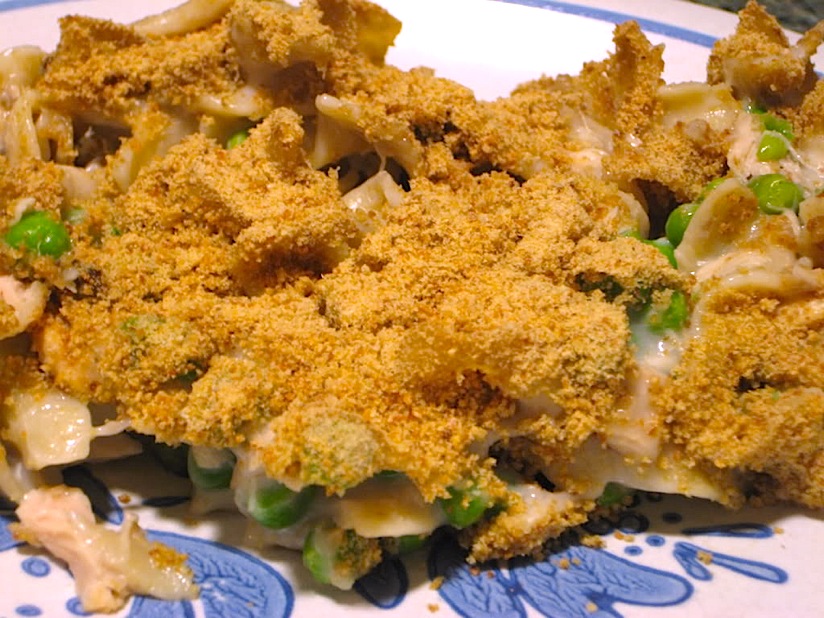


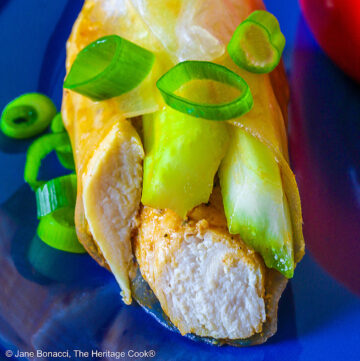
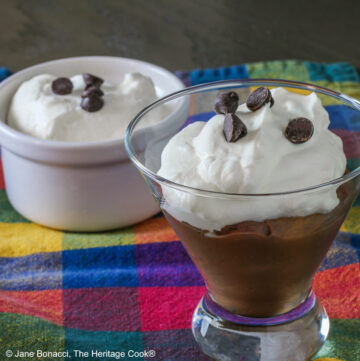
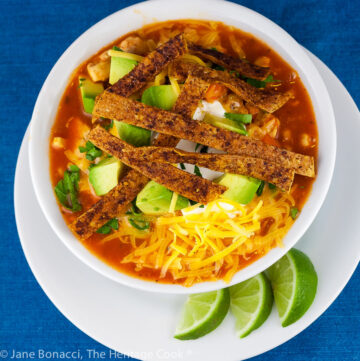
The Food Hound
You know, I LOVE tuna noodle casserole (one of the few times I enjoy pasta), but I will never, ever make it with condensed soup- yuck. This looks delicious! I will definitely try it! I’ll toy with the idea of making it with bread cubes instead of pasta, and maybe adding some broth so it doesn’t come out too dry. Hmmmm… 🙂
Jane Bonacci, The Heritage Cook
Thank you Ladies! I’m with you FH, I just can’t stand the thought of using condensed soup. I hope you try this recipe and let us know what you think! Bread cubes is an interesting idea …
Shelby
This looks YUMMY!